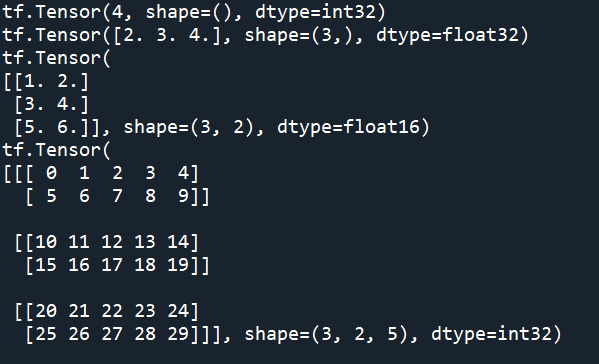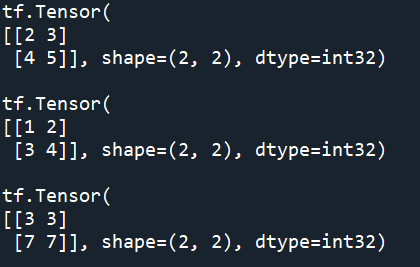tensorflow学习笔记
张量
import tensorflow as tf #创建常量 rank_0_tensor = tf.constant(4) print(rank_0_tensor) #创建一阶张量(向量) rank_1_tensor = tf.constant([2.0, 3.0, 4.0]) print(rank_1_tensor) #创建二阶张量(向量) rank_2_tensor = tf.constant([[1, 2], [3, 4], [5, 6]], dtype=tf.float16) print(rank_2_tensor) #创建三阶张量(向量) rank_3_tensor = tf.constant([ [[0, 1, 2, 3, 4], [5, 6, 7, 8, 9]], [[10, 11, 12, 13, 14], [15, 16, 17, 18, 19]], [[20, 21, 22, 23, 24], [25, 26, 27, 28, 29]],]) print(rank_3_tensor)

张量的运算
a = tf.constant([[1, 2], [3, 4]]) b = tf.constant([[1, 1], [1, 1]]) print(tf.add(a, b), "\n") #加法 print(tf.multiply(a, b), "\n") #逐元素乘法 print(tf.matmul(a, b), "\n") #矩阵乘法

形状操作
tf.shape([[[1, 1, 1], [2, 2, 2]], [[3, 3, 3], [4, 4, 4]]],name=None) #返回数据的shape
tf.Tensor([2 2 3], shape=(3,), dtype=int32)
tf.size([[[1, 1, 1], [2, 2, 2]], [[3, 3, 3], [4, 4, 4]]], name=None) #返回数据的元素数量
tf.Tensor(12, shape=(), dtype=int32)
tf.rank([[[1, 1, 1], [2, 2, 2]], [[3, 3, 3], [4, 4, 4]]],name=None) #返回tensor的rank
tf.Tensor(3, shape=(), dtype=int32)
切片
input=[[[1, 1, 1], [2, 2, 2]],[[3, 3, 3], [4, 4, 4]],[[5, 5, 5], [6, 6, 6]]] print(tf.slice(input, [1, 0, 0], [2, 1, 3]))
tf.Tensor(
[[[3 3 3]]
[[5 5 5]]], shape=(2, 1, 3), dtype=int32)
激活函数
tf.nn.relu(features, name=None) tf.sigmoid(x, name=None) tf.tanh(x, name=None)
卷积函数
tf.nn.conv2d(input, filter, strides, padding, use_cudnn_on_gpu=None, data_format=None, name=None) tf.nn.conv3d(input, filter, strides, padding, name=None)
池化函数
tf.nn.avg_pool(value, ksize, strides, padding, data_format=’NHWC’, name=None) #平均方式池化 tf.nn.max_pool(value, ksize, strides, padding, data_format=’NHWC’, name=None) #最大值方法池化




 浙公网安备 33010602011771号
浙公网安备 33010602011771号